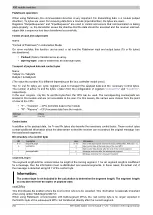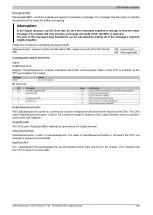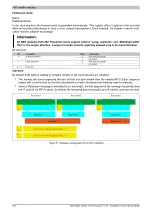
X90 mobile modules
X90 mobile system User's manual V 1.20 - Translation of the original manual
211
Transmitting data to a module (output)
When transmitting data, the transmit array must be generated in the application program. Sequences are then
transferred one by one using Flatstream and received by the module.
Information:
Although all B&R modules with Flatstream communication always support the most compact trans-
fers in the output direction, it is recommended to use the same design for the transfer arrays in both
communication directions.
_data_01
_data_02
_data_03
_data_04
_data_05
_data_xx
. . .
TxBytes
CPU fills
OutputMTU with
the next
sequence of the
transmit array
If OutputMTU
is enabled:
Transmit array
Type: USINT
OutputMTU
Type: USINT
PLC / Bus controller
The transmit buffer
of the module is
adapted cyclically
to OutputMTU
via X2X
_data_01
_data_02
_data_03
_data_04
_data_05
_data_xx
. . .
*RxBytes
Module adds the transmit buffer
to the internal array
If successful:
InputSequenceAck is
adapted to the
transmit counter
If counter OutputSequence
is increased:
Module-internal
receive array
Type: USINT
Module-internal
receive buffer
Type: USINT
Module
Cycl.
Figure 47: Flatstream communication (output)
The length of the message is initially smaller than OutputMTU. In this case, one sequence would be sufficient to
transfer the entire message and the necessary control byte.
Algorithm
Cyclic status query:
- The module monitors OutputSequenceCounter.
0) Cyclic checks:
- The CPU must check OutputSyncAck.
→ If OutputSyncAck = 0: Reset OutputSyncBit and resynchronize the channel.
- The CPU must check whether OutputMTU is enabled.
→ If OutputSequenceCounter > InputSequenceAck: MTU is not enabled because the last sequence has not yet been acknowledged.
1) Preparation (create transmit array):
- The CPU must split up the message into valid segments and create the necessary control bytes.
- The CPU must add the segments and control bytes to the transmit array.
2) Transmit:
- The CPU transfers the current element of the transmit array to OutputMTU.
→ The OutputMTU is transferred cyclically to the module's transmit buffer but not processed further.
- The CPU must increase OutputSequenceCounter.
Reaction:
- The module accepts the bytes from the internal receive buffer and adds them to the internal receive array.
- The module transmits acknowledgment and writes the value of OutputSequenceCounter to OutputSequenceAck.
3) Completion:
- The CPU must monitor OutputSequenceAck.
→ A sequence is only considered to have been transferred successfully if it has been acknowledged via OutputSequenceAck. In order to detect potential trans-
fer errors in the last sequence as well, it is important to make sure that the length of the
Completion
phase is run through long enough.
Note:
To monitor communication times exactly, the task cycles that have passed since the last increase of OutputSequenceCounter should be counted. In this way,
the number of previous bus cycles necessary for the transfer can be measured. If the monitoring counter exceeds a predefined threshold, then the sequence
can be considered lost.
(The relationship of bus to task cycle can be influenced by the user so that the threshold value must be determined individually.)
- Subsequent sequences are only permitted to be transmitted in the next bus cycle after the completion check has been carried out successfully.
















































